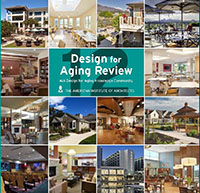|
|
August 2015 Issue
Letter from the Chairs
Summer Greetings Blueprints Readers!
The topic of this issue is on "resiliency." Enjoy the articles on this topic submitted by your fellow peers!
The next Blueprint's theme will focus on how nature is incorporated into building design for the aging community. Dwellings enclose and protect us from the elements but they can also house, frame and invite nature in. Is living closer to nature of particular benefit for aging?
Here are some possible areas to explore: How do buildings connect with landscapes, gardens, views, animals, fresh air, and greenery in a convenient and accessible way for the elderly? Many projects include natural materials, therapeutic outdoor spaces, out buildings, sun or screen rooms, and wander gardens. How do these elements benefit seniors? Does a close bond between the inside and outside, between people and the environment, enhance health, well-being, and social participation?

|
|
|
|
DFAR12 Book on Sale for $45
 |
|
This compilation of more than 30 outstanding projects in the areas of assisted living, continuing care retirement communities, and nursing homes represents the best current work designed by architects for the ever-increasing aging population.
Each project is presented with photographs, detailed plans, and statistics, illuminating the high level of research, planning and community involvement that goes into these advancements in living environments for seniors. |

Features
Project Profile: Richmond Terrace
By Sam Beall - Richmond Terrace has been home to Vermont seniors since 1985. This affordable housing community consists of 16 apartments and was originally funded by the HUD 202 senior housing capital and rental assistance program. Built to the average standards of its time and therefore never particularly energy efficient, the building’s condition had worsened over time: windows were leaky; ice damming (including 8’ icicles!) was a recurring issue; the fuel oil boilers had reached the end of their useful life; utilities averaged $30,000/year and water rates had doubled in the past year.

|
 |
Summer in the City: Preparing the Built Environment for Extreme Heat Events
 |
By Nicholas B. Rajkovich, PhD, AIA - Each year in the United States, more people die from heat waves than from any other type of natural disaster (CDC 2009). The National Climate Assessment projects an increase in the risk, intensity, and duration of extreme heat events over the next century (Melillo, Richmond et al. 2014). Elderly populations are at risk for heat-related morbidity and mortality because of changes in how the body regulates temperature as it ages; seniors are also more likely to live alone, have reduced social contacts, and have medical conditions like heart or renal disease (Luber and McGeehin 2008).

|
UD & Resiliency
By Thomas Hirsch, FAIA - To "age in place" is the overwhelming preference of Americans yet our existing housing stock is woefully under-designed for all that to happen. All too often a change in people's abilities necessitates a change in residence which is disruptive to social connections & supports, disorientating if cognitive abilities are involved, and incredibly wasteful of building materials and energy.

|
 |
Housing Crisis, Climate Change and the Elder in Nunatsiavut (Labrador- Canadian Arctic)
 |
By Alain Fournier, Architect, OAQ, OAA, ALBNL, FRAIC - Inuit populations across Inuit Nunangat (all Inuit Territories in the Canadian Arctic) have suffered for decades through severe housing shortage and overcrowding conditions. The effects of rapid climate change in the Arctic have further compounded the deterioration of the already overused and abused housing stock. Housing has become a wide spread crisis, impacting the very social fabric and health of the Inuit communities. Elderly people are particularly vulnerable to housing related health issues.

|
In the News
2018 FGI Guidelines Proposal Period Now Open
Proposals must be submitted in the FGI electronic proposal system no later than October 15, 2015.
The public is invited to submit proposals to update and improve any part of the content of the current edition of the FGI Guidelines: the 2014 Guidelines for Design and Construction of Hospitals and Outpatient Facilities and the 2014 Guidelines for Design and Construction of Residential Health, Care, and Support Facilities. To help your proposals get fair consideration, please read the tips for writing proposals posted in the proposal system.

Be the Solution: A Universal Design Primer
By Deborah Pierce | Remodeling
It’s time for builders and designers to get comfortable with the notion of aging. From Medicare to Alzheimer’s, from home care to estate planning, aging is the subtext of conversations everywhere these days. And rightly so, because an unprecedented 10,000 people are now reaching retirement age every day. These are the baby boomers, members of what once was the largest population bubble in history and a major driver of economic and cultural trends from the start.

Sustainable: Resiliency is Next Stage for Building Design
By Frank Jossi | Finance & Commerce
Resiliency is fast becoming the buzzword in architecture and construction as the next evolution of sustainability. Trying to figure out just what it means, however, is a challenge. What does it mean that a building is resilient? What are the standards for resiliency?

Upcoming Events
2015 LeadingAge Annual Meeting and Expo
The LeadingAge Annual Meeting & EXPO in Boston, MA, November 1-4, 2015, will have over 190 inspiring educational sessions that explore how we can Be The Voice for change that makes lives better today and in the future.
Attendees will be able to:
- Choose from more than 150 expert-led education sessions.
- Connect with thousands of aging services professionals from across the country.
- Take home solutions that address the many pressing challenges facing your community/organization.
Don't miss the 2015 Design for Aging Forum (Session 45-C) on Monday, November 2, from 3:15 - 4:45pm where the Design for Aging Review 13th Edition Award recipients will be officially announced and honored. There will also be a Design for Aging Reception held immediately following the forum, just blocks away from the Boston Convention Center at the Boston Society of Architects/AIA BSA Space located at 290 Congress Street.

Upcoming Webinars
Computation, Metrics, and Data Analysis in Practice
Tuesday, September 22, 2015 | 2:00 - 3:00pm ET | Earn 1.0 AIA LU | Learn more | Register now
Sponsored by AIA Technology in Architectural Practice
Registration fees: Free
Guide to Using AIA Contract Documents and Software In-Person!
Friday, September 25, 2015 | 9:00 - 5:00pm ET | Earn 6.5 AIA/CES LUs | Learn more and register
Sponsored by AIA Contract Documents
Registration fees: $299 (Members and Non-Members)
The AIA Leadership Institute - October 23, 2015
Participate in a one-day, shared national dialogue on leadership and architecture and earn up to 7 LUs. The re-envisioned and re-designed AIA Leadership Institute will bring timely, relevant leadership training to AIA members across the country. Attend at one of our 2015 locations: Boston, Cleveland, Phoenix, San Antonio, or Washington, DC.

|
. 
|
Resources
Become a Citizen Architect
 |
AIA is calling on members across the country to join the Advocacy Network as Citizen Architects. Whether you are looking to make a difference in your local community or advance leadership across the spectrum of government, institutions, or neighborhoods, identifying as a Citizen Architect allows AIA to recognize civically engaged members to provide the tools you need to make the impact you desire.
 |
New AIA Member-Only Research Databases Now Available through BRIK
Professionally-reviewed research is available through the Building Research Information Knowledgebase (BRIK). The BRIK collection is free and can be navigated by search terms such as aging. This portal now includes a subscription feature to three EBSCO databases: the Sustainability Reference Center, Art & Architecture Complete, and the Avery Index to Architectural Periodicals. The EBSCO-powered portion of BRIK is offered to AIA members and to NIBS members. A free test drive of these databases is underway through September, after which members can subscribe for a nominal annual fee.

Latest Version of Design Guidelines for the Visual Environment
Since the Low Vision Design Committee was first convened in 2011 under the auspices of the National Institute of Building Sciences and with the support of the Hulda B. & Maurice L. Rothschild Foundation, this task force has stayed true to their initial objective. Their recent publication, Design Guidelines for the Visual Environment, is designed to inform the regulatory and design communities about the challenges experienced by low vision populations and to provide specific design recommendations regarding the visual environment in order to afford equal access to all facilities through universal design principles.

|
|
|
|
|
|







